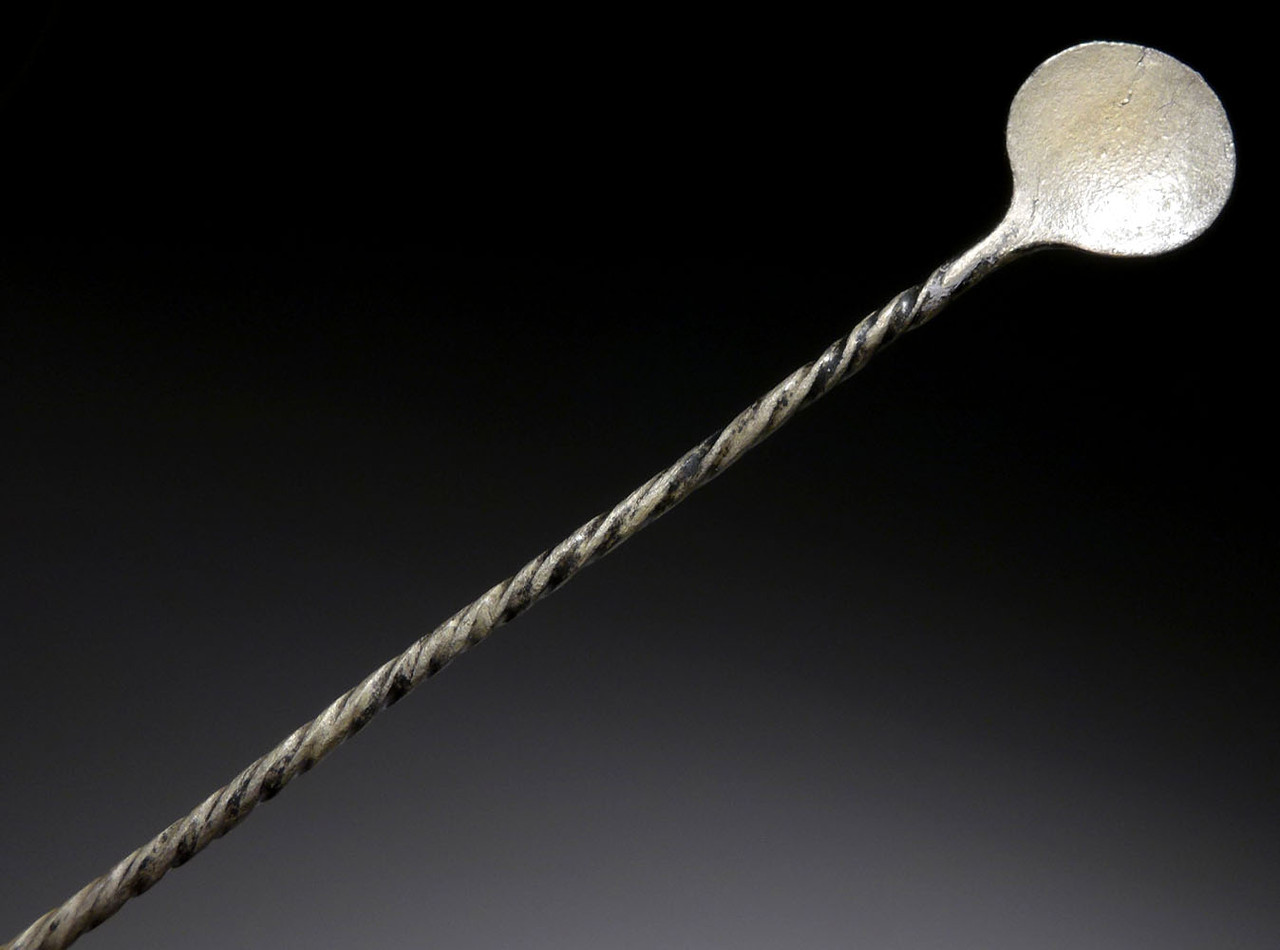Product Description
SEE MORE PRE-COLUMBIAN ARTIFACTS
This is an amazing collection of THREE precious silver objects of the ancient Pre-Columbian Chimu Indians dating to a period from 800-1200 A.D.. Purportedly found together, the set includes a large primary tupu disk pin, a medium size tupu disk pin and an extremely rare silver spoon with an exquisitely twisted stem handle. Since silver was not found in alluvial deposits like gold, it was often considered more precious and scarce. As the Chimu worshipped the Moon, they placed a special importance on silver objects. A Pre-Columbian field worker's chant in ancient Peru states, ''The sun rains gold, the moon rains silver.'' Silver was an extremely precious and special metal to the ancient peoples of Pre-Columbian South America as silver had to be mined, smelted and refined from ore. Gold, on the other hand, could be found in placer deposits such as stream beds. Because of this, silver was scarcer than gold and the reason there are far fewer silver Pre-Columbian objects than those in gold.
Believed to have come from the moon, silver was considered a feminine element and only the most noble, wealth classes had the privilege to own it. All three objects were each hammered and forged from a single piece silver, a task only the most gifted silversmith could have achieved. Silver Chimu hammered metalwork craft is scarce and this set represents not only extreme prestige in the ancient world, but also one of great artist handcraft achievement.
HISTORY
The Chimú culture arose about 900 AD, succeeding the Moche culture, and was later conquered by the Inca emperor Topa Inca Yupanqui around 1470, fifty years before the arrival of the Spanish in the region. The Chimu culture was centered on Chimor with the capital city of Chan Chan, a large adobe city in the Moche Valley of present-day Trujillo, Peru. The Chimú occupied a strip of desert on the north coast of Peru. The rivers in the region carved a series of fertile valley plains, which were very flat and well-suited to irrigation. Agriculture and fishing were both very important to the Chimú economy.
Worshipping the moon, the Chimú, unlike the Inca, considered it more powerful than the sun. Offerings played an important role in religious rites. A common object for offerings, as well as one used by artisans, was the shell of the Spondylus shellfish, which resides only in the warm coastal waters off present-day Ecuador. Associated with the sea, rainfall, and fertility, Spondylus shells were highly valued and traded by the Chimú people, and the exchange of the shells played a significant economic and political role in the empire.
The Chimú people are best known for their distinctive monochromatic pottery and fine metal working of copper, gold, silver, bronze, and tumbaga (copper and gold). Some Chimú artisans worked in metal workshops divided into sections for each specialized treatment of metals: plating, gold, stamping, lost-wax, pearl, the watermark, and embossing wooden molds. These techniques produced large variety of objects, such as cups, knives, containers, figurines, bracelets, pins, and crowns. The Chimú were famous for shaping metals through hammering. Chimú metalsmiths achieved this technique with simple tools and a single sheet of metal, hammered over a wooden form.
Although copper is found naturally on the coast, it was mostly attained from the highlands in an area about 3 days away. Since most of the copper was imported, it is likely that most of the metal objects that were made were likely very small. The pieces, such as wires, needles, digging stick points, tweezers, and personal ornaments, are consistently small, utilitarian objects of copper or copper bronze. The Tumi is one well-known Chimú work. They also made beautiful ritual costumes of gold compounds with plume headdresses, earrings, necklaces, bracelets, and breastplates.
 US DOLLAR
US DOLLAR
 EURO
EURO
 AUSTRALIAN DOLLAR
AUSTRALIAN DOLLAR
 CANADIAN DOLLAR
CANADIAN DOLLAR
 POUND STERLING
POUND STERLING














